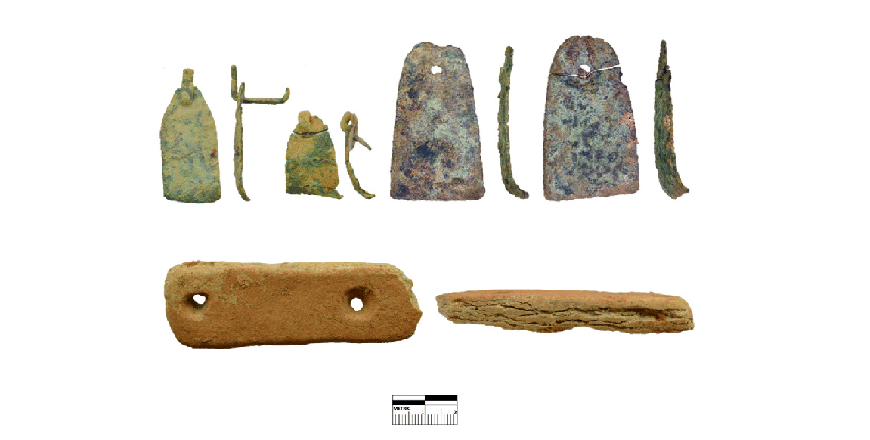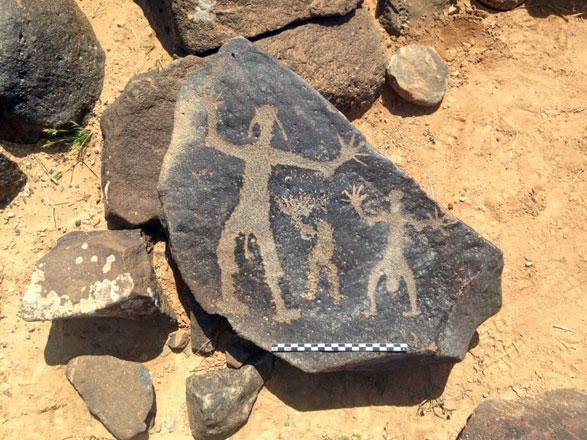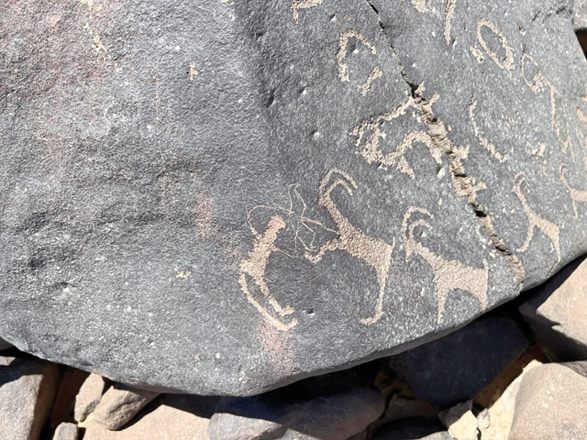You are here
Weaponry Tales from Jebel Qurma: Decoding figurative art, tombs’ preservation
By Saeb Rawashdeh - Jan 27,2024 - Last updated at Jan 27,2024

Weaponry found during the 2017-2018 fieldwork campaigns in cairn burials in the Jebel Qurma region (Photo courtesy of Jabel Qurma Project)
AMMAN — The Safaitic inscriptions within the Black Desert depict scenes from the daily life of the pre-historic inhabitants, in this arid and inhospitable environment. The Black Desert, like Hishma Desert in the south, contains thousands of inscriptions and petroglyphs spanning from immemorial times to more recent periods.
Inscriptions in Safaitic and petroglyphs were carved into the dark basalt boulders that litter the landscape, showing a variety of figurative and geometric motifs, said a Dutch archaeologist.
“Whereas the Safaitic texts have received considerable attention, research on the contemporaneous petroglyphs has remained limited,” noted Keshia Akkermans, from The University of Liverpool, adding that a notable advancement is the recent doctoral dissertation focusing on the rock art of the Jebel Qurma area, which comprises the first systematic, contextual study of the contents and motifs of the rock art of the Black Desert.
Akkermans highlighted specific motifs, such as women and chariots.
“The majority of figurative depictions in the rock art of the Jebel Qurma region consist of zoomorphic figures, while anthropomorphic representations make up a relatively small percentage. The main category of material culture depicted in the petroglyphs is that of weaponry,” she underlined, adding that studies on the motifs and objects in rock art can provide valuable insights into material culture used by its makers, especially in regions where the archaeological record is complicated due to numerous issues.
For example, artefacts found in the burial cairns in the Jebel Qurma region are often poorly preserved, due to the porous construction of the cairns, their continuous reuse, looting and the region’s extreme climatic conditions, the archaeologist explained.
Such extreme weather conditions also impacted the preservation of weaponry in these tombs, and the excavations retrieved only a handful of examples.
“In the Jebel Qurma area, burial tombs were the only places that contained preserved weaponry. Two tombs yielded some weapons made of iron, in the form of at least five arrowheads, a javelin and a potential spearhead,” Akkermans explained, adding that the javelin and four of the arrowheads were found in the original (but collapsed) grave chamber of a so-called “ring cairn”. The cairn had undergone several phases of re-use and alteration since its initial construction, also looting in antiquity, which left the original grave heavily disturbed.
“Moreover, a subsequent phase of reuse levelled the top half of the ring cairn and used it as a foundation to build a straight-walled ‘tower tomb’ on top of it. A fifth arrowhead and the possible spearhead were found in a burial,” Akkermans underlined, adding that the arrowheads have simple, leaf-shaped blades and lozenge tangs.
She explained that “a more common find in the burial cairns were the bronze armour scales, which were about 2.5cm long, 1.5cm wide and 0.1cm thick and they came from graves dated to the mid and late first millennium BC, but were never present together with iron weapons or with any other weaponry”.
The research team found scales of armour from the Classical and most of the scales are curved at the wider end, presumably to further aid adherence to the under-cloth.
“The scales were found in several tombs but, curiously, their quantity per grave is very low. Most scales have been found as single pieces or, occasionally, in small groups of only two or three per cairn,” Akkermans highlighted.
Perhaps they were segments that fell off during looting activities in antiquity, which removed the armour corselets from the tombs, the archaeologist speculated, adding that alternately (and probably more likely), the armour scales may have served a ritual purpose in the mortuary practices of the region.
Related Articles
AMMAN — The Jabal Qurma Archaeological Landscape Project started in 2012, with extensive field surveys and excavations in the basalt desert
AMMAN — Ancient tombs found in Jordan’s Eastern Desert indicate a “flourishing” culture that managed to adapt to the harsh conditions of the
AMMAN — The inhabitants of the inhospitable Black Desert were often overlooked or wrongly perceived by contemporaries from ancient political


















